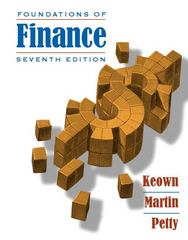Question
For example, suppose a stock is selling for $61 and there are three-month call options at $57, $60, and $63. The prices of the options
For example, suppose a stock is selling for $61 and there are three-month call options at $57, $60, and $63. The prices of the options are $6, $3, and $1, respectively.
a) The investor expects the price of the stock to be stable. What would the investor gain or lose at the option ?expiration from constructing an appropriate butterfly spread at the following prices of the stock: $50, $55, $57, $63, $65, and $70?
b) What is the maximum possible loss?
c) What is the maximum possible gain?
d) What is the range of stock prices that produces a gain from constructing this butterfly?
e) Did the butterfly achieve its objective based on the expectation that the price of the stock would be stable?
 The price of a stock is $51. You can buy a six-month call at $50 for $5 or a six-month put at $50 for $2. a) What is the intrinsic value of the call? b) What is the intrinsic value of the put? c) What is the time premium paid for the call? d) What is the time premium paid for the put? e) If the price of the stock falls, what happens to the value of the put? f) What is the maximum you could lose by selling the call covered? g) What is the maximum possible profit if you sell the stock short? After six months, the price of the stock is $58. h) What is the value of the call? i) What is the profit or loss from buying the put? j) If you had sold the stock short six months earlier, what would your profit or loss be? k) If you sold the call covered, what would your profit or loss be? SOLUTION a. Intrinsic value of the call: $51 - 50 = $1 b. Intrinsic value of the put: $50 - 51 = $nil ($0) c. Time premium for the call: $5 - 1 = $4 d. Time premium for the put: $2 - 0 = $2 e. As the price of the stock falls, the value of the put rises (i.e., there is a negative relationship between the value of the stock and the put). f. If the investor sells the call covered, the maximum possible loss is the cost of the stock minus the proceeds of the sale of the call: $51 - 5 = $46. g. If the price of the stock fell to $0, the profit (and the maximum possible profit) on the short position is $51. Questions h - k assume the passage of six months. h. The intrinsic value (price) of the call is $58 - 50 = $8. i. The put is worthless; loss is the purchase price: $2. j. The loss would be $51 - 58 = ($7). k. Profit on the stock: $58 - 51 = $7 Loss of the option: $5 - 8 = (3) Net profit: $4
The price of a stock is $51. You can buy a six-month call at $50 for $5 or a six-month put at $50 for $2. a) What is the intrinsic value of the call? b) What is the intrinsic value of the put? c) What is the time premium paid for the call? d) What is the time premium paid for the put? e) If the price of the stock falls, what happens to the value of the put? f) What is the maximum you could lose by selling the call covered? g) What is the maximum possible profit if you sell the stock short? After six months, the price of the stock is $58. h) What is the value of the call? i) What is the profit or loss from buying the put? j) If you had sold the stock short six months earlier, what would your profit or loss be? k) If you sold the call covered, what would your profit or loss be? SOLUTION a. Intrinsic value of the call: $51 - 50 = $1 b. Intrinsic value of the put: $50 - 51 = $nil ($0) c. Time premium for the call: $5 - 1 = $4 d. Time premium for the put: $2 - 0 = $2 e. As the price of the stock falls, the value of the put rises (i.e., there is a negative relationship between the value of the stock and the put). f. If the investor sells the call covered, the maximum possible loss is the cost of the stock minus the proceeds of the sale of the call: $51 - 5 = $46. g. If the price of the stock fell to $0, the profit (and the maximum possible profit) on the short position is $51. Questions h - k assume the passage of six months. h. The intrinsic value (price) of the call is $58 - 50 = $8. i. The put is worthless; loss is the purchase price: $2. j. The loss would be $51 - 58 = ($7). k. Profit on the stock: $58 - 51 = $7 Loss of the option: $5 - 8 = (3) Net profit: $4 Step by Step Solution
There are 3 Steps involved in it
Step: 1

Get Instant Access to Expert-Tailored Solutions
See step-by-step solutions with expert insights and AI powered tools for academic success
Step: 2

Step: 3

Ace Your Homework with AI
Get the answers you need in no time with our AI-driven, step-by-step assistance
Get Started


